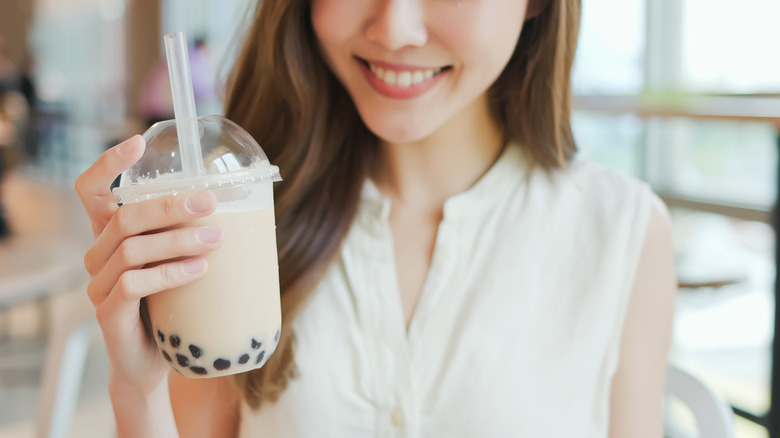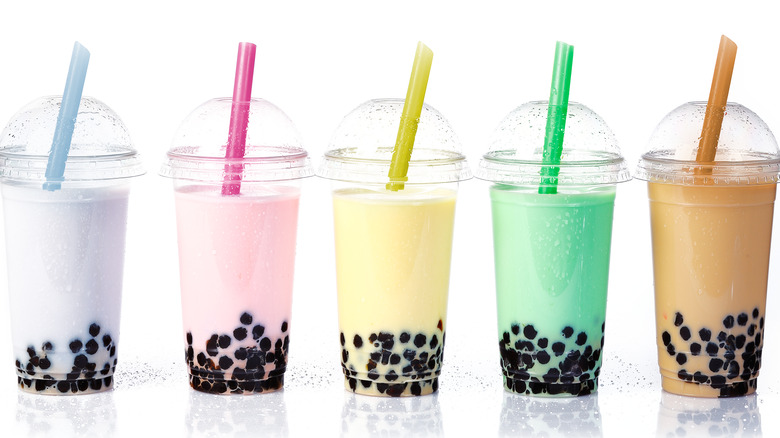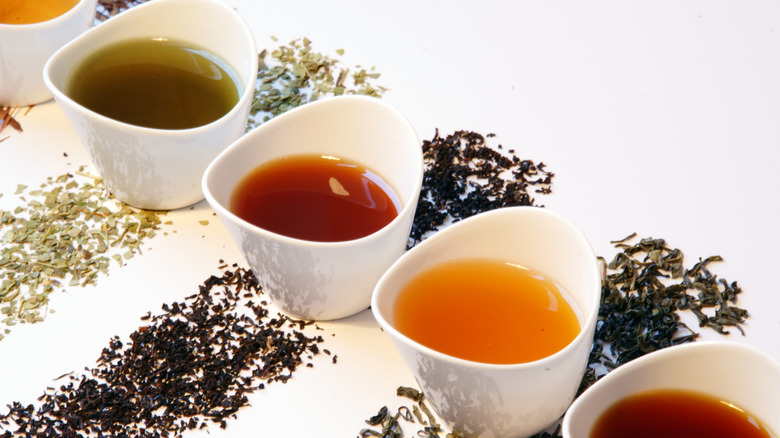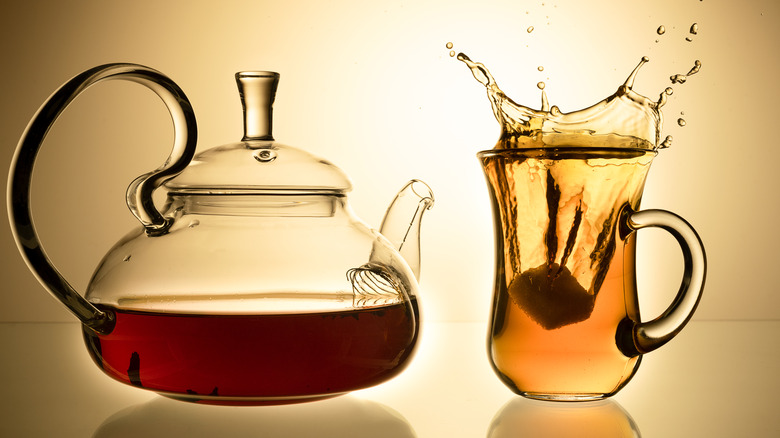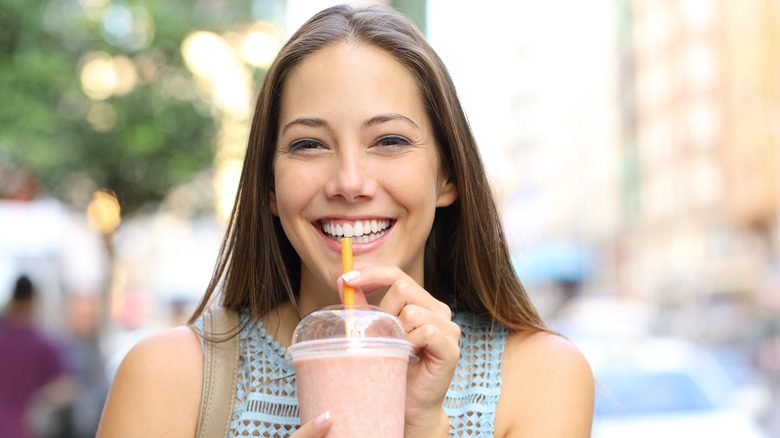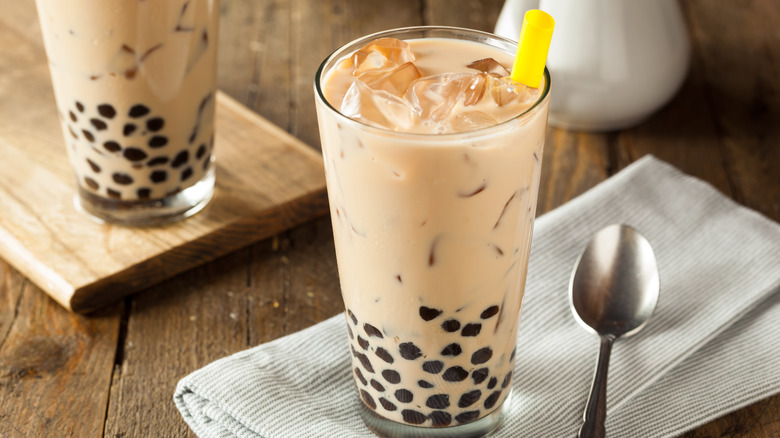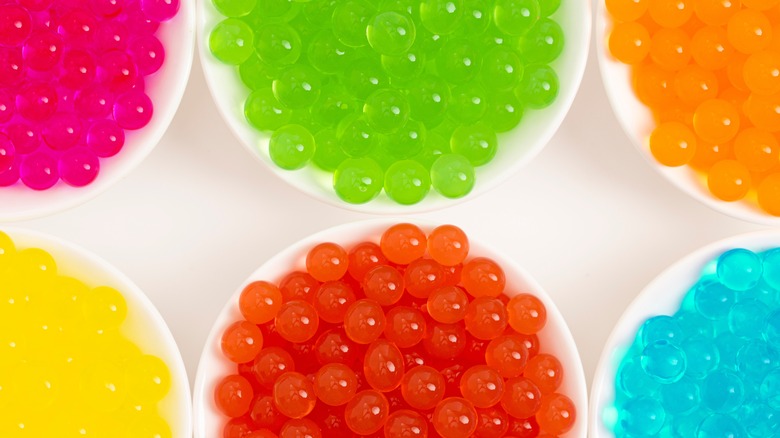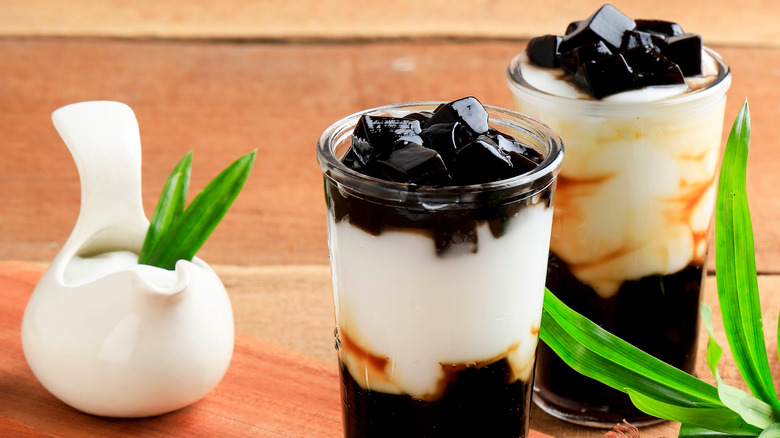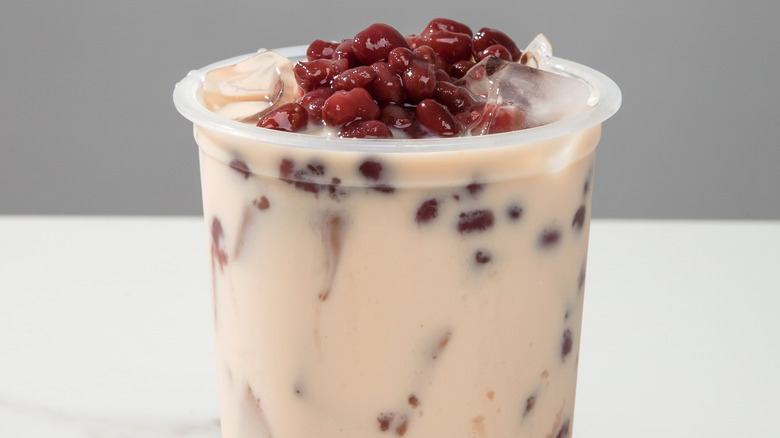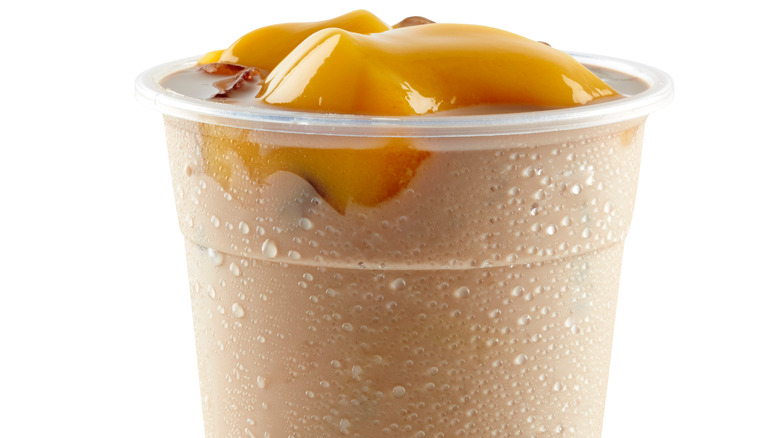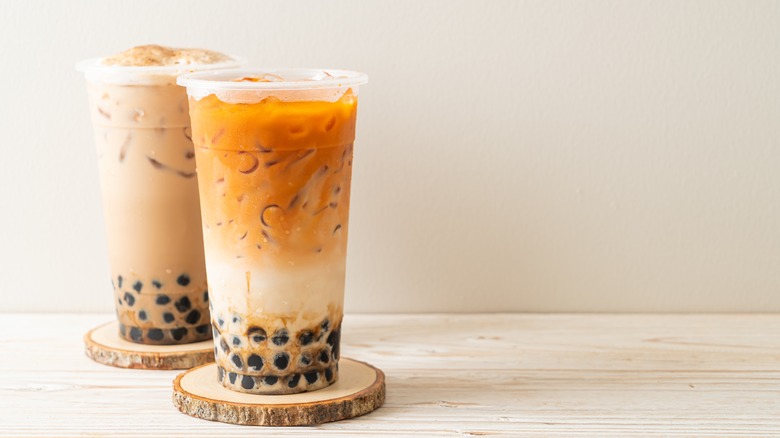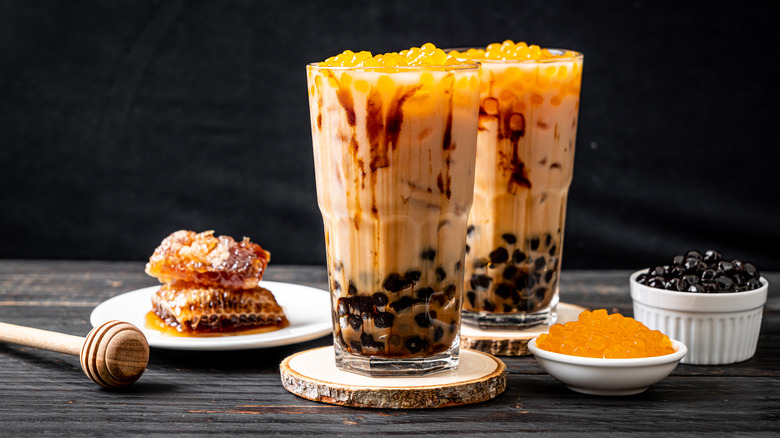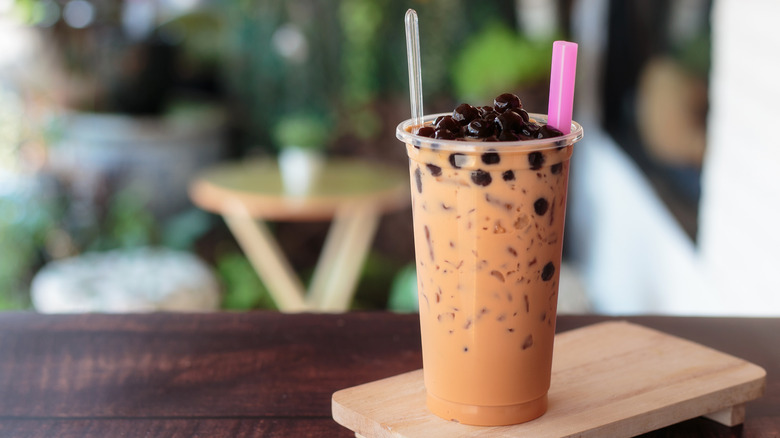A Beginner's Guide To Ordering At A Bubble Tea Shop
Bubble tea as we know it today was first served in Taiwan in the 1980s. There is a bit of contention over which teahouse in Taiwan actually invented the drink, as many think it was Chun Shui Tang Teahouse located in the central part of the country, while others are sure it was Hanlin Tea Room in the south, per LA Weekly. But, no matter where the drink was first poured, there is something we can all agree on: Bubble tea is delicious.
Since becoming a staple of Asian-American culture in the early 2000s, the sweet tapioca drink has skyrocketed in popularity across all demographics. These days, there seems to be a bubble tea shop on nearly every corner. However, if you have never had bubble tea before, breaking into the market can seem a bit intense. This makes sense as there a lot of customizations you can make to your drink, including literally hundreds of options to choose from. To take the stress out of ordering and get you well on your way to the drink of your dreams, we've broken down how to order a bubble tea, step by step.
1. Fruit tea vs. milk tea
The first thing you need to decide when you walk into a bubble tea shop is whether you want a fruity tea, or a milk-based tea. Both options are delicious, but have their own differences. The good thing is that there are no surprises and both drinks are almost entirely what they sound like. Milk teas are very similar to the cup of tea you might have in the morning. They come in different flavors and varieties, but are essentially the green or black tea of your choice mixed with milk. In most cases, bubble tea shops will use whole milk. If you have a dairy intolerance, you can ask if there are non-dairy milks available.
If there are not any, or you prefer something a little bit sweeter, consider selecting a fruit-based tea instead. Drinking a fruit tea is a lot like enjoying a lemonade, but just not quite as tart. They come in many different flavors like peach, guava, and, yes, even lemon. If you aren't sure about what to choose, ask the barista for their favorite drink as a suggestion.
2. Green tea vs. black tea
After you select the variant of your tea, the next thing the barista will ask you is which type of tea you prefer to have: Green tea or black tea. In some unique cases, the tea you select will only come in one or the other. In that case, you can skip this step. However, for most options, you will have to choose. According to Artful Tea, the biggest difference between the two types of tea is how tea companies process them. Black tea is processed in a way that ensures lots of oxidation. This means the tea is left out and exposed to oxygen for longer to impact its nutrients and flavor profile. Green tea is heated early in the process to stop it from oxidizing, which means the leaves retain their green color, hence its name.
The location of the teas' origin is also different. Green teas come from China and Japan, while black teas usually come from China and India. However, when selecting the option for your drink, the most important thing to know is the tea's flavor profile. Black teas tend to be stronger tasting, while most others would describe green tea as soft.
3. Hot tea vs. iced tea
Once you know what kind of tea and flavor you would like, the next thing you have to choose is whether or not you want the drink hot or cold. There are many health benefits, as well as unique notes of flavor, to both options. Whether tea is hot or cold, it contains plenty of nutrients and antioxidants. Nutrients nourish our bodies and supplement the other foods we eat, while antioxidants are known to help us repair our bodies and fight off infections.
Hot tea is perfect for warming you up on a cold day, or helping you relax and unwind after a long shift at work. Iced tea tastes delicious during the summer, or to help you wash down some delicious bánh mì, a Vietnamese sandwich often sold at bubble tea shops. However, because bubble tea is typically served cold, there are some things to consider when warming it up. Milk teas tend to heat better than fruit teas, per Full Coffee Roast. In addition, only the classic tapioca pearls can stand up against the heat. Most other items you can add to the drink tend to melt under hotter temperatures.
4. Slushie vs. smoothie
The final choice to make is whether you want to upgrade to a slushie or a smoothie. According to Julie's Cafe Bakery, the most noticeable difference between the two types of drink is their consistency, but that's not the only way they differ. At its core, a smoothie is an option prepared with more whole foods. It typically includes fruit, a select few vegetables, as well as juice, milk, or yogurt. If you are visiting a bubble tea shop in the morning and want a pick-me-up for breakfast, a classic fruit smoothie could be a perfect choice.
On the other hand, a slushie is more of a dessert type of beverage. The main ingredient of a slushie is typically plenty of crushed ice, which gives the drink its classic crunchy texture. This is followed by adding a flavored, sugary syrup to give the drink the flavor of your choice. Overall, both options are perfect to choose, it just depends on what you are in the mood for when you order. To spice things up, consider adding a few sinkers to your drink, like boba.
5. Classic tapioca: bubbles, boba, pearls
When you think about bubble tea, the black tapioca pearls inside the drink are probably what first come to mind. Although it has many names, like bubbles, boba, and pearls, this chewy ball of flavor is the most popular sinker choice of all. Due to their weight, and tendency to sink to the bottom of the cup, what you might consider toppings for your tea are commonly referred to as sinkers in most bubble tea shops.
According to Bubble Tea Training, tapioca pearls are very simple in terms of ingredients, as there are only two main ones: Tapioca starch and water. The dark pearls that are most popular in most bubble tea shops get their color from the addition of brown sugar during the cooling process. So, the pearls end up tasting a bit like brown sugar gummy candy. Often, they begin to take on the flavor of the drink you add them to — whether it's a classic milk tea, a matcha latte, or even a simple peach green tea. If you are unsure if you will like the taste and texture of boba, you can typically ask the barista for a free sample before paying to add them to your drink.
6. Sinker choice: popping boba
Many who don't like bubble tea cite tapioca as a reason they won't come back for more. So, if you are someone who struggles with the texture of solid tapioca pearls, but still want to add a little decoration to your drink, you should try popping boba instead. According to Fanale Drinks, the topping is also often used by frozen yogurt chains and potentially better known as bursting fruit bubbles.
This option differs from traditional boba in composition because the balls are a little smaller and hollow inside. The outer coating is also made from seaweed extract, instead of chewy tapioca, so it is way easier to bite through. When you bite down, you don't need to use a lot of pressure before the bubble instantly pops and covers your tastebuds with a delicious coating of fruit juice. Popping boba comes in a variety of flavors, like mango, strawberry, and lime. This sinker choice tends to work best with fruit teas, as the fruit juice inside might clash with the flavors of most milk teas. However, as you explore the world of bubble tea, feel free to mix and match to see what works best for you.
7. Sinker choice: different types of jelly
If you already love tapioca and want to expand your sinker choices, consider ordering jelly in your drink next time. There are many different types of jelly you can choose from, depending on the flavor profile that you enjoy. If you want a shot of espresso in your milk tea, you can choose to add coffee jelly. If you couldn't decide between peach tea and mango tea, you can have both by adding mango jelly into your peach tea. There are even less common types of jelly available, like grass jelly or aloe vera. According to the Webstaurant Store, grass jelly is a bit of a misnomer. The classic dessert isn't actually made from grass at all, but gets its name from its green color instead. This is caused by the plant used to make it, Chinese mesona. Grass jelly doesn't taste like grass either, rather it tastes very herbal, kind of like mint tea.
Grass jelly and other traditional types like lychee, peach, and grape are made in a very similar way. You simply combine boiled fruit with a sweetener of your choice, as well as a binding agent, like gelatin or Agar-Agar, per Pearl Lemon Boba. Once cooled, you can cube off the substance and enjoy.
8. Sinker choice: red beans
While you might not immediately think of beans and bubble tea as a winning combination, trust us — you are going to love it. According to Savor Japan, red beans are traditionally known as anko in Japanese cuisine. It gets this name because when Chinese foods, including sweet buns, arrived in the country in the 7th century, local monks didn't want to eat meat. So the monks swapped the meat, known as anko, for a red bean paste which looked similar. Anko was originally a savory choice, but as its use became more widespread, Japanese cooks began sweetening it with boiled ivy sap, and eventually sugar.
From its humble beginnings in Japan, anko — or sweetened red beans — are now a staple in many desserts across Asia. If you enjoy drinks with contrasting textures, you will likely enjoy the beans in your tea. Even when fully submerged in the liquid, the beans maintain their firm texture, adding excitement to each sip. When bitten into, sweetened red beans taste a bit like candied nuts. They have a subtle, earthy flavor that nicely complements the tang of a fruit tea or the sweetness of a milk tea. If you are unsure about adding beans to your bubble tea, ask the barista if you can try a sample before deciding.
9. Sinker choice: egg pudding
Another popular sink choice you will see available in most bubble tea shops is egg pudding. According to Honest Food Talks, egg pudding is a very popular dessert across Asian cultures. Since many folks enjoy bubble tea as a sweet treat, it makes sense to combine the two indulgences. Egg pudding is pretty straightforward to make, so if you are concerned about any allergens, you only need to avoid it if you are sensitive to eggs, milk, or sugar.
By combining these three ingredients, you are left with a very sweet dessert with a light taste and airy texture. Typically, you would use egg pudding as the base layer of milk tea. As it sinks to the bottom of the cup, the egg pudding begins to dissolve and thickens the overall texture of the drink. However, if you catch an undissolved portion with your straw, it also tastes delicious. You can compare the experience to eating a chunk of Oreo from the bottom of a glass of milk. The excess sugar from the pudding makes the tea a bit sweeter and, when combined in a sip with a tapioca pearl, is nice and tangy.
10. Select your sweetness level
From health concerns to personal taste preferences, there are many reasons you might want to control the amount of sugar in your bubble tea. According to the USDA, added sugar should be kept to a minimum each day, at less than 10% of total foods consumed. The great thing is that just like every other aspect of your drink, its sugar level is entirely customizable. Each drink has about 1½ to 3 tablespoons of sugar inside, depending on your choice of flavor and the amount of sinkers you add in, per Talk Boba.
When ordering, simply tell the barista if you would like to reduce the sugar content in your drink. Most bubble tea places will have a small chart on the counter telling you the different levels of sweetness offered at that location. These are typically from zero to 100, stopping at each quarter along the way. For your first couple of drinks, ask the barista if you can make your drink 50% sweet. You can always add in more sugar after the fact if it tastes too bland, but if it is too sweet for you, you won't be able to enjoy it at all. From there, you can adjust the sugar level up or down to fit your personal preferences.
11. Select your ice level
The final thing you will be asked at a bubble tea shop is how much ice you want in your drink. There is no right or wrong answer here, as it is entirely personal preference. According to Desert News, most Americans prefer to have plenty of ice in their beverages, while it is less common in Europe and Asia to have iced drinks, especially when the weather is chilly.
Some bubble tea shops will have a diagram on the counter of the different levels of ice available. Ranging from no ice to extra ice, there are likely a few stops in between, around the 25%, 50%, and 75% marks. You just have to point to the option you would prefer. If they don't have the chart, you might need to bring up your preference when ordering. If you want your drink extra cold, ask for full ice. If you have teeth sensitivity, consider asking for "less ice," which typically puts you around the 50% mark.
A small thing to consider when selecting your ice level is the overall shape of the cup. If you find that you enjoy the taste of the sinkers and want to eat all of them, get less ice. As you consume the liquid in the cup, sinkers will inevitably get left behind. It is a lot harder to fish them out at the end if there are heaps of ice cubes in the way.
12. Popular bubble tea flavors to try
It's true that walking into a bubble tea shop for the first time can be really overwhelming. If you are still unsure what drink to order, a safe bet is to try asking the barista what the most popular drink at the shop is. Often, they might have a personal favorite they can share with you, or suggest one of one of the top selling drinks at that location. If you don't want to ask, many bubble tea shops have a popular drinks and specials list either on the printed menu, or on one of the digital screens.
While you typically can't go wrong ordering one of those, here are a few international favorites to try to get you started off on the right foot. First, if you want something milky, consider Thai milk tea. It's a creamy black tea served with condensed milk to make it extra sweet. As with most other black teas, Thai tea comes with a number of health benefits, like lowering blood pressure and decreasing inflammation in the body, per WebMD. Another milky option to try is Hong Kong milk tea, which is another black tea that is very popular in Asia. Most bubble tea shops would simply sell this choice as "milk tea." If you want something lighter, you can't go wrong with peach or mango green tea, as both fruity options taste fresh with a similar flavor profile to sweetened lemonade.
